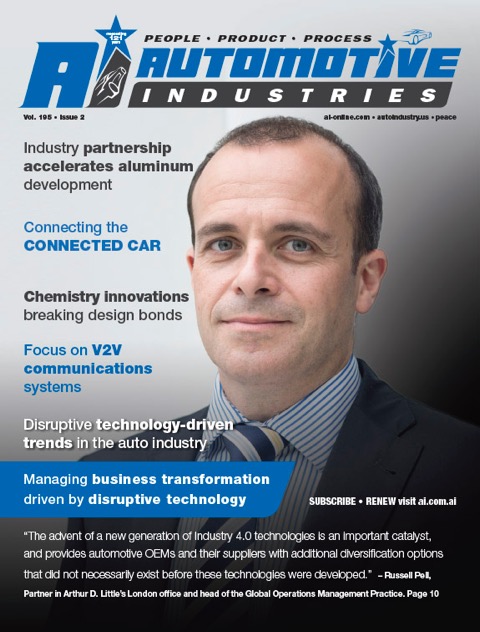
Industry 4.0 and related new technologies such as the Internet of Things (IoT) are changing the face of industry.
“CXOs in all industries are currently defining new ways to explore and exploit the benefits. The bad news is that the variety of technologies and limited number of industrialized examples make it hard to understand the complexity of the topic. The good news is that the concepts are far more than buzzwords. The new technologies have actual game-changing potential. Savings of between 15 and 50% per cost line can be achieved on the operations side,” says an excerpt from a White Paper “Future of Operations in the Digital World”, co-authored by Bernd Schreiber, Wolf-Dieter Hoppe, and Benjamin Schoenefuss of Arthur D Little.
An example is the case of a leading Tier1 automotive supplier with several hundred manufacturing sites which decided to incorporate modern technologies into its manufacturing and supply-chain operations. A key challenge was that the operations were historically organized at division level, with limited standardization and centralized control.
Together with Arthur D. Little the company assessed 20 different technology areas and ranked their potential for the different parts of the operations based on current technological maturity, savings potential and required implementation effort. Following this assessment the key technologies for the supplier were selected, and an organization was established at group level to implement the transformation. This team is responsible for realizing an estimated 1.2 bn. EUR of savings enabled by these technologies by 2025. Their task is to develop expertise, build networks with technology providers and other early adopters and maintain an ambitious portfolio of pilot and implementation projects. The first round of 20 implementation projects, launched during the project with Arthur D. Little, is already scheduled to bring savings of 70–100 m EUR within three years, according to the White Paper.
Automotive Industries (AI) asked Russell Pell, a partner in Arthur D. Little’s London office and head of the Global Operations Management Practice, how the concepts of “cyber-physical systems” and “additive manufacturing” are changing the face of industry.
Pell: Cyber-physical systems allow simulation and/ or real-time control across sites and parties in a way not previously possible by linking them with each other through clearly defined and standardized interfaces. These systems present organizations with new ways to create value – for example by optimizing the interface between “smart” machines and products to enable highly customized production and optimize production efficiency. Additive manufacturing offers an alternative to traditional centralized process manufacturing techniques by enabling low-volume, high-value parts to be produced and distributed more quickly and at lower cost, without compromising performance. In some cases there may even be performance benefits, for example as a result of weight savings – which can be particularly important for the automotive sector.
AI: In your paper “Confronting Core Market Decline” you say that established manufacturing industries need to rethink their business strategies – please expand.
Pell: The resource and manufacturing industries may provide a useful reference point for industrial service organizations looking to embark on a fundamental review of their business models. Companies in the resources and manufacturing industries are being forced by new market realities – not least, lower commodity prices – to rationalize existing operations and where possible diversify into alternative sectors. In the same vein the providers of industrial services may need to adopt a similar pragmatic approach when faced with the decline of core markets.
AI: How would this impact established automotive manufacturers?
Pell: In many respects, the response of automotive manufacturers to core market decline is still being played out, and remains to be seen. Nonetheless, the advent of a new generation of Industry 4.0 technologies is an important catalyst, and provides automotive OEMs and their suppliers with additional diversification options that did not necessarily exist before these technologies were developed. These new possibilities will see automotive OEMs, automotive suppliers and a breed of “challenger” organizations try to establish new positions along the industry supply chain, with potential to fundamentally change how value is created and distributed in the industry.
AI: How do industries prepare for the ongoing digital revolution?
Pell: Industries that wish to reap the full benefits of the digital revolution are questioning the relevance of established business models, however effective they have been to date. This includes a thorough re-evaluation of how value is created, and how the industry creates customer value. To achieve this, companies will normally need to look beyond short-term quick-wins and engage in the fundamental reworking of underlying processes, systems and capabilities – a process that takes time, but needs to be initiated now in order to realize later benefits. At the end of the day, the key is to recognize that digital creates opportunities, but also a great deal of uncertainty. Many industries are therefore focusing a lot of effort on how to maintain flexibility and adaptability to make use of these opportunities.
AI: What are the dangers of not keeping up with today’s realities such as the Internet of Things?
Pell: Many of the traditional barriers of who does what in the industry are breaking down. Although there may be a temptation to maintain the status-quo, especially in uncertain economic times, companies that do not start to familiarize themselves with, and embrace the transformative potential of technologies like Internet of Things, may find themselves facing competitive disadvantages relative to more agile competitors in the long term. These disadvantages include a higher cost base, failure to capture additional revenue streams and an inferior customer experience. The competition is just as likely to come from an entirely unexpected source as it is from traditional competitors in one part of the market.
AI: How have automotive manufacturers responded to all these developments?
Pell: Automotive OEMs are at different stages in their level of adoption of Industry 4.0 technologies, so it is important not to generalize. Nonetheless, the more advanced manufacturers are making greater use of related technologies. For example, by using additive manufacturing to reduce the cost of component production and by deploying new technologies into core manufacturing processes to realize productivity benefits. They are working out how crucial it is to understand the broader picture, and to identify the opportunities available to them. Anyone not doing so, in our view, is exposing themselves to higher risk. In many ways, the technology itself is the easy bit! Much harder are the issues associated with identifying new ways of working, and winning the hearts and minds of employees to drive through the changes needed.
AI: How has your firm helped automotive manufacturers navigate these new waters?
Pell: We continue to work with leading automotive OEMs and suppliers to help them to adapt to the fundamental challenges of the industries in which they compete. While the needs of every organization are different, our clients are recognizing how their industry is indeed in transition and undergoing significant disruption









More Stories
Towing Services Explained: 6 Key Facts You Need to Know
Environmental Factors That Influence Ceramic Coating Choices
Professional vs. DIY Tinting: What You Should Know